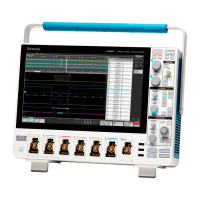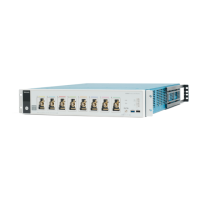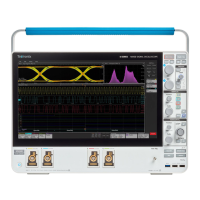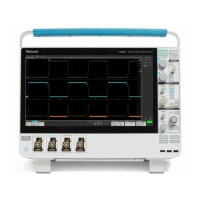Analog channel operating basics
Acquiring a signal
After acquiring a signal you can take measurements and plot the results.
Use the following procedure to set the scale and position parameters for analog signal acquisition.
1. Press the Default Setup button.
2. Connect the probe output to the desired oscilloscope channel, and connect the probe input to the input signal source using proper
probing/connecting techniques.
Note: Some probes automatically set their termination and other values.
3. T
ap the channel button to add the channel waveform to the waveform view and add a channel badge to the setting bar. A channel
button lights when its channel is on.
4. Double-tap the channel badge to open the channel Vertical Settings menu. To change the input coupling, select the appropriate
coupling button.
• Select DC to couple both the AC and DC components of an input signal.
• Select AC to couple only the AC components of an input signal.
5. Use the Vertical knobs to scale and position the waveform vertically on the screen. The Knobs should be highlighted with the active
channel's color. Dragging the waveform handle also positions the waveform.
6. Use the Vertical Settings menu to change the offset. Tap Offset, and then use a multipurpose knob to adjust the offset.
7. Use the Horizontal knobs to scale and position the waveform horizontally on the screen and to set the record length. Dragging the
reference icon also positions the waveform.
8. Use the Horizontal menu to set the record length and sample rate (when in Manual mode).
9. You may attempt to stabilize the display by pressing the trigger Level knob to set the trigger level to 50%. The 50% level is calculated
as the midpoint between the highest and lowest samples of the acquired waveform. If your signal is periodic you should see a stable,
triggered signal. This method will not work as well with random signals.
Autoset to quickly display a waveform
The Autoset function analyzes the signal characteristics and changes the instrument Horizontal, Vertical, and Trigger settings to
automatically display a triggered waveform. You can then make further changes to trigger and horizontal settings to view the waveform
point of interest.
1. Connect the probe with the signal of interest to an available channel.
2. Double-tap the Trigger badge and set the trigger source to that of the signal of interest.
3. Connect any other associated signal(s) to available channel input(s).
4. Add the channel waveforms to the Waveform view. See Add a channel waveform to the display on page 61.
5. Tap File > Autoset or push the front-panel Autoset button. When using the Stacked Display mode, the instrument analyzes the signal
characteristics of the trigger source channel (analog or digital) and adjusts the horizontal, vertical, and trigger settings accordingly
to display a triggered waveform for that channel. The Vertical scale is adjusted in each waveform slice of all active waveforms to
maximize ADC utilization.
Analog channel operating basics
2 Series MSO MSO24 and MSO22 57
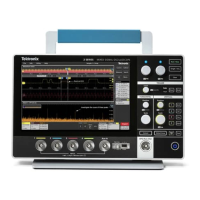
